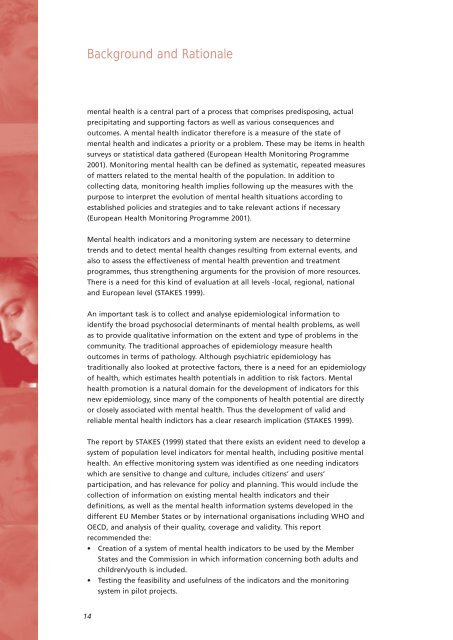4858 Mental Health Report - National University of Ireland, Galway
4858 Mental Health Report - National University of Ireland, Galway
4858 Mental Health Report - National University of Ireland, Galway
Create successful ePaper yourself
Turn your PDF publications into a flip-book with our unique Google optimized e-Paper software.
Background and Rationale<br />
mental health is a central part <strong>of</strong> a process that comprises predisposing, actual<br />
precipitating and supporting factors as well as various consequences and<br />
outcomes. A mental health indicator therefore is a measure <strong>of</strong> the state <strong>of</strong><br />
mental health and indicates a priority or a problem. These may be items in health<br />
surveys or statistical data gathered (European <strong>Health</strong> Monitoring Programme<br />
2001). Monitoring mental health can be defined as systematic, repeated measures<br />
<strong>of</strong> matters related to the mental health <strong>of</strong> the population. In addition to<br />
collecting data, monitoring health implies following up the measures with the<br />
purpose to interpret the evolution <strong>of</strong> mental health situations according to<br />
established policies and strategies and to take relevant actions if necessary<br />
(European <strong>Health</strong> Monitoring Programme 2001).<br />
<strong>Mental</strong> health indicators and a monitoring system are necessary to determine<br />
trends and to detect mental health changes resulting from external events, and<br />
also to assess the effectiveness <strong>of</strong> mental health prevention and treatment<br />
programmes, thus strengthening arguments for the provision <strong>of</strong> more resources.<br />
There is a need for this kind <strong>of</strong> evaluation at all levels -local, regional, national<br />
and European level (STAKES 1999).<br />
An important task is to collect and analyse epidemiological information to<br />
identify the broad psychosocial determinants <strong>of</strong> mental health problems, as well<br />
as to provide qualitative information on the extent and type <strong>of</strong> problems in the<br />
community. The traditional approaches <strong>of</strong> epidemiology measure health<br />
outcomes in terms <strong>of</strong> pathology. Although psychiatric epidemiology has<br />
traditionally also looked at protective factors, there is a need for an epidemiology<br />
<strong>of</strong> health, which estimates health potentials in addition to risk factors. <strong>Mental</strong><br />
health promotion is a natural domain for the development <strong>of</strong> indicators for this<br />
new epidemiology, since many <strong>of</strong> the components <strong>of</strong> health potential are directly<br />
or closely associated with mental health. Thus the development <strong>of</strong> valid and<br />
reliable mental health indictors has a clear research implication (STAKES 1999).<br />
The report by STAKES (1999) stated that there exists an evident need to develop a<br />
system <strong>of</strong> population level indicators for mental health, including positive mental<br />
health. An effective monitoring system was identified as one needing indicators<br />
which are sensitive to change and culture, includes citizens’ and users’<br />
participation, and has relevance for policy and planning. This would include the<br />
collection <strong>of</strong> information on existing mental health indicators and their<br />
definitions, as well as the mental health information systems developed in the<br />
different EU Member States or by international organisations including WHO and<br />
OECD, and analysis <strong>of</strong> their quality, coverage and validity. This report<br />
recommended the:<br />
• Creation <strong>of</strong> a system <strong>of</strong> mental health indicators to be used by the Member<br />
States and the Commission in which information concerning both adults and<br />
children/youth is included.<br />
• Testing the feasibility and usefulness <strong>of</strong> the indicators and the monitoring<br />
system in pilot projects.<br />
14
















